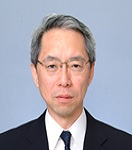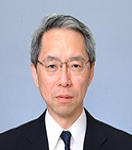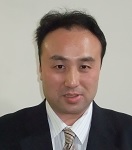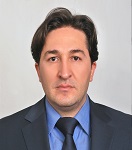Day 1 :
Keynote Forum
William Tumas
National Renewable Energy Laboratory, USA
Keynote: The terawatt photovoltaic energy challenge: Status, recent advances and materials by design

Biography:
William Tumas is the Associate Laboratory Director for Material and Chemical Science Technology at the National Renewable Energy Laboratory (NREL) with R&D on solar energy, hydrogen, energy storage, fuel cells, materials science, chemical/nanoscience and technology reliability. He is the Director of the Center for Next Generation of Materials by Design (CNGMD) EFRC. Prior to NREL, he has spent 17 years at Los Alamos National Laboratory. He has worked at Dupont Central Research for 6 years after a Post-doctorate at Caltech and a PhD from Stanford University.
Abstract:
Meeting our future global energy needs in a sustainable manner constitutes one of the greatest challenge the world is facing in the 21st century and will require advances in energy conversion, delivery, storage and utilization. Solar energy, particularly photovoltaics, can meet much of the world’s energy demands. Remarkable improvements in the performance, efficiency, costs and reliability are leading to phenomenal growth in deployment of photovoltaics energy worldwide; however, it only accounts for a small portion of total energy production today. This talk will provide an overview of the current status of photovoltaic solar cell technology along with remaining technical challenges for the development and deployment of the needed terawatts of solar energy. Key advances and remaining barriers for materials, devices and systems that span commercial, emerging and new technology platforms will be presented. We will provide an overview of NREL’s extensive program in photovoltaic research, development and deployment that aims to address the US Department of Energy SunShot goals as well as efforts to further decrease the costs of solar energy (i.e. beyond grid parity). The discovery of new functional materials is critical to developing disruptive technologies. Key results on materials by design from the next generation for materials by design (CNGMD) energy frontier research center (EFRC) will be presented, where we tightly couple theory, experiment and characterization to discover and understand new inorganic semiconductor materials for photovoltaic absorbers, transparent conductors, photoelectrochemical water splitting and related applications.
Keynote Forum
David A Schiraldi
Case Western Reserve University, USA
Keynote: Green materials – Which are really green?

Biography:
David A Schiraldi has completed his PhD in Chemistry from the University of Oregon and worked in the chemical/polymer industry for 20 years, then moved to the Department of Macromolecular Science & Engineering at Case Western Reserve University, where he is currently the department Chairman. He has published approximately 200 peer-reviewed papers, holds 20 US patents, launched a startup company, is a Fellow of the American Chemical Society and is on the Advisory Boards of a number of journals and academic departments.
Abstract:
Keynote Forum
Yoshitomi Morizawa
Asahi Glass Co., Ltd., Japan
Keynote: Fluorinated organic compound and green sustainability

Biography:
Morizawa spent one year in a laboratory of late professor H. G. Viehe at Universite Catholique de Louvain in Louvain-la-Neuve, Belgium, during the period of the doctoral course, and undertook a PhD in industrial chemistry at Kyoto University (JAPAN) in 1984 under the guidance of professor emeritus Hitosi Nozaki. Immediately, he found a job in Asahi Glass Co., Ltd. He has been engaged in the development of fluorinated organic compounds in the field of specialty chemicals, especially pharmaceutical drugs, agrochemical agents, intermediates, fluoropolymers, fluorination methods, and their processes. Since 2009, he has been Fellow of Research Center. He has published more than 60 papers in journals and filed a patent of more than 140.
Abstract:
Fluorinated organic compounds have generally unique properties, such as high heat and chemical resistances, high durability to ultra violet light, low friction coefficient, low surface tension, low adhesion, low dielectric constant, and low refractive index, etc. based on the high electron negativity, relatively small van der Waals radii of fluorine atom itself, and high C-F bond energy. Therefore, many pharmaceuticals, agrochemicals, anaesthetics, refrigerants, and high performance materials such as plastics, elastomers, membranes, textile finishes, and coatings contain fluorine atom(s) within their structures for exhibiting their important properties. It can be said that fluorine is an essential element for life and impacts on the general public. The presentation will be discussed the contribution of the fluorinated materials to green sustainability with demonstrating some examples.
- Track 1: Green Catalysis
Track 3: Green Synthesis and Designing
Track 8: Organic Synthesis
Track 9: Industrial Applications of Green Chemistry
Track 13: Green Nanotechnology
Location: Embassy Suites Las Vegas

Chair
David A Schiraldi
Case Western Reserve University, USA

Co-Chair
William Tumas
National Renewable Energy Laboratory, USA
Session Introduction
David A Schiraldi
Case Western Reserve University, USA
Title: Using nature to flame retard polyolefins

Biography:
David Schiraldi has a PhD in Chemistry from the University of Oregon, worked in the chemical/polymer industry for 20 years, then moved to the Department of Macromolecular Science & Engineering at Case Western Reserve University 14 years ago, where he is the department Chairman. He has published approximately 200 peer-reviewed papers, holds 20 U.S. patents, has launched a startup company, is a Fellow of the American Chemical Society, and is on the advisory boards of a number of journals and academic departments.
Abstract:
Synthetic polymers bring great value to life, but suffer from their oil/gas-derived flammabilities. Halogenated, and more recently phosphorous-based flame retardants have been used for the past generation to reduce fire danger in these products, but in many cases raise toxicology and regulatory issues. Nature has evolved materials over the years which reduce fire danger in the biosphere; some of these, as well as some unexpected materials can be added to man-made products with great effect. This talk will discuss potential bio-based flame retardant systems which significantly reduce the flammability of polyethylene and polypropylene. Mechanical and UL(94) flammability test results will be presented along with detailed material compositions. The work demonstrates that combinations of naturally occurring, low-toxicity additives can be added to polyethylene and polypropylene with no significant loss of mechanical properties, but achieving V(0), self-extinguishing/non-dripping performance.
Yoshitomi Morizawa
Asahi Glass Co., Ltd, Japan
Title: Environmentally benign organohalogen chemistry in asahi glass

Biography:
Morizawa spent one year in a laboratory of late professor H. G. Viehe at Universite Catholique de Louvain in Louvain-la-Neuve, Belgium, during the period of the doctoral course, and undertook a PhD in industrial chemistry at Kyoto University (JAPAN) in 1984 under the guidance of professor emeritus Hitosi Nozaki. Immediately, he found a job in Asahi Glass Co., Ltd. He has been engaged in the development of fluorinated organic compounds in the field of specialty chemicals, especially pharmaceutical drugs, agrochemical agents, intermediates, fluoropolymers, fluorination methods, and their processes. Since 2009, he has been Fellow of Research Center. He has published more than 60 papers in journals and filed a patent of more than 140.
Abstract:
Fluorinated organic compounds are widely applied in day to day life and in industry, especially in the field of specialty chemicals such as plastics, elastomers, membranes, textile finishes, coatings, pharmaceutical drugs and agricultural agents, based on the unique properties of fluorine atom(s). Among them, perfluorinated compounds are important components in industrial materials, taking advantages of thermal stability and chemical resistance for infrastructural architectures and electronics applications. However, there were some limitations in the synthesis of the perfluoro building blocks or the precursors because of the difficulty of perfluorinated moiety synthesis and C-F bond forming reaction. The direct fluorination method with fluorine gas in liquid phase overcame the subject, i.e. all the hydrogen atoms in the molecule which is synthesized at will using normal hydrocarbon chemistry are replaced with fluorine atoms at once, even in the case of having functional groups such as carbonyl, ethereal group, etc. The process contributes the reduction of the environmental burden, since the product or the intermediate is used as a solvent, and hydrogen fluoride is the only cogenerated product, theoretically1, 2). On the other hand, methacrylate resin (PMMA) is one of the most important polymers used mainly as optical materials. The monomer, methyl methacrylate (MMA), is manufactured by acetone cyanohydrin (ACH) method, C4 direct oxidation method, and alpha process etc. However, it is not possible to avoid the usage of hydrogen cyanide gas and the byproduct of ammonium sulfate contaminated with organic compounds in ACH method, for example. We have newly developed the efficient method starting with acetone and chloroform in the presence of base and acid catalyst, via chloroisobutyroyl chloride, to produce MMA3). In this case, hydrogen chloride is only a byproduct. These technologies with controlling the high reactivity of fluorine atoms and transforming the chlorinated compounds to the desired constructions could contribute to the establishment of the environmentally benign processes.
Andrew C Flick
Pfizer Global Research and Development, USA
Title: Modern green chemistry considerations in synthetic medicinal chemistry

Biography:
Andy was born and raised in St. Louis, MO. After earning a bachelor’s degree in chemistry from Lake Forest College, he joined Array BioPharma in Longmont, CO in 2001. He then joined Albert Padwa’s laboratory at Emory University in Atlanta, Georgia studying dipolar cycloaddition approaches to alkaloid natural product synthesis. Upon completion of his doctorate in 2008, he joined Pfizer and has worked on small molecule drug discovery projects within the Neurosciences, Rare Diseases, and Inflammation & Immunology therapeutic areas. He has authored over 25 peer-reviewed publications and several patents. His other interests include ice hockey, poker, and boating.
Abstract:
As the pharmaceutical industry continues to evolve, increased attention to the environmental impact of drug discovery and manufacturing processes has continued to drive a focus on the application of green chemistry principles across the continuum of drug discovery. With the development of new synthetic strategies, methodologies, and technologies that are enabling rapid access to a diverse range of valuable chemical space, opportunities continue to surface to identify and implement sustainable processes. Examples of the development and application of green chemistry principles within the synthetic routes for our drug discovery programs will be discussed. As complexity increases within modern molecular targets, the discipline must continue to focus on identifying and applying these efficiencies wherever possible.
Sharda Goel
Maharshi Dayanand University, India
Title: An efficient and versatile method for synthesis of 1,4-Dihydropridines at mild reaction conditions

Biography:
Sharda Goel is an eminent Professor in Organic Chemistry in the department of Chemistry, M. D. University, Rohtak. She has forty papers to the credit in national and international journals of high repute. She has been attending and participating in conferences and seminars at national and international levels and contributing to the discipline of chemistry.
Abstract:
Polyhydroquinolines are fused heterocyclic compounds which exhibits bactericidal, fungicidal, analgestic and anti-inflammatory activities and act as hypotensive and anticancer agents. Due to their biological importance, there has been considerable interest in developing new synthetic methods for the preparation of polyhydriquinolines. Herein as a part of our efforts to develop new synthetic method in heterocyclic chemistry, we report an environmentally benign, efficient and convenient protocol for the synthesis of derivatives of polyhydroquinoline by combining dimedone, ethylacetoacetate and ammonium acetate with various substituted arylaldehydes in good to excellent yields by a grinding method under solvent-free conditions. The process is simple, straightforward, environmentally benign and easily leads to the synthesis of desired polyhydroquinolines i.e ethyl 4-phenyl-2,7,7-trimethyl-5-oxo-1,4,5,6,7,8-hexahydro-quinoline-3-carboxylate. The catalyst is easily available and inexpensive. This method proves to be advantageous in terms of excellent yields and short reaction times. In recent years, with the emphasis on adoption of cleaner green chemistry processes, a tremendous interest has been observed in carrying out various chemical transformations under heterogenous conditions owing to simplicity in operation. Among phase transfer catalysts, TEBAC (triethylbenzylammoniumchloride) has gained immense popularity in organic synthesis in last few decades. Owing to all the advantages of TEBAC, the development of TEBAC catalysed organic reactions is still an attractive research area in the coming future.
Brindaban C Ranu
Indian Association for the Cultivation of Science, India
Title: New approaches for green and cost-effective metal catalysis

Biography:
Brindaban C Ranu started his independent research career in 1985 at Indian Association for the Cultivation of Science, Kolkata, India after completing his PhD from Jadavpur University, India and Post-doctoral studies at Virginia Tech, USA. He has been promoted as Professor in 1996 and Senior Professor in 2006. Currently, he is INSA Senior Scientist and J C Bose National Fellow at the same institute. His primary research interest lies in green synthesis and green catalysis. He has published more than 257 papers in reputed journals with an H-index of 52. He is a Fellow of INSA and IASc.
Abstract:
Metals play an important role as catalyst in organic synthesis and have been instrumental in many key transformations. Several noble and expensive metals such as platinum, gold, silver and palladium have been demonstrated to catalyze many important reactions. However, for better cost management and environmental concern use of less expensive and more environment friendly metals are desirable. Thus, the main focus of our group’s activity is directed to benign and inexpensive metal catalyzed C-C and carbon-heteroatom bond formation leading to the synthesis of bioactive molecules. For example, we have developed a recyclable heterogeneous catalyst of Cu (II) anchored on Al2O3 surface that has been successfully used for several reactions. One of them is Cu (II)/Al2O3 catalyzed solvent controlled selective N-arylation of cyclic amides and amines leading to important scaffolds of potent therapeutic agents. We have also developed a novel concept of using two appropriate inexpensive metals in place of expensive metal like palladium and ligand, where one metal takes active part in catalysis and other one is assisting the process. Using this protocol copper-assisted nickel catalyzed ligand free Csp-Csp and Csp-Csp2 cross-coupling providing a direct access to unsymmetrical 1,3-diynes and en-ynes, and Co/Cu catalyzed C(sp2)-O cross-coupling have been achieved among others, our another approach is to design metal free reaction which is traditionally mediated by metals. Thus, we have developed a visible light photocatalyzed direct conversion of aryl/heteroaryl amines to selenides at room temperature.
Claudio RodrÃguez MartÃnez
National Center of Biological Products, Cuba
Title: Applications of nanoclays in diagnostic microbiology

Biography:
Claudio Rodríguez graduated as an Engineer and completed his PhD at the Moscow State University of Applied Biotechnology (former MTIIMP) in Russia. For the past 21 years he has been the Director of Research at the National Center of Biological Products in Cuba. He is author of more than 30 granted patents in Cuba, Europe, USA and other countries and has published several papers in international journals. He and his research team have developed more than 20 new products and technologies in the field of diagnostic microbiology.
Abstract:
With the development of nanotechnology new materials based on the transformation, modification, or combination of natural clays have been obtained for different applications in microbiology. Most of these applications are directed to inhibit the growth of bacteria and fungi combining them with solver and other inhibiting substances. Nevertheless, nanotechnology opens new possibilities to detect and identify microorganisms with high accuracy and in few minutes. Different technologies were developed based on the fabrication of nanocomposites with nanoceramics, monoclonal antibodies, DNA or RNA fragments, and biomarkers. Our group has developed a technological platform for the fast and accurate detection of bacteria and fungi by combining nanoclays and nanoceramics with enzyme specific fluorogenic and chromogenic substrates. We also included in the composition different nutrients and activators of the microbial metabolism that allow reduction of the lag phase of bacterial growth and the detection of specific enzymes activity at this early stage of growth. With these new nanocomposites we have been able to identify different microorganisms within few minutes. As an example, it was possible to detect E. coli directly in urine sample in just 10 minutes allowing the further timely and efficient antibiotic therapy.
Roberto Rosa
University of Modena and Reggio Emilia, Italy
Title: Environmental assessment of different synthetic strategies towards engineered oxide nanomaterials

Biography:
Roberto Rosa graduated in Chemistry in 2005 at the University of Modena and Reggio Emilia, from which he also obtained his PhD in Materials Science in 2011 and from that year he is a Postdoctoral Research Fellow at the same University. His main research interests are related to the application of microwaves as alternative and efficient energy form in the inorganic syntheses of engineered nanomaterials, in the green extraction of phytochemical compounds and in materials processing in general. He is co-authors of more than 30 publications on reputed scientific journals.
Abstract:
In the evaluation and selection of a particular synthetic strategy for the preparation of desired engineered nanomaterials, careful considerations on the size and the shape of nanocrystals must accompany the conventional considerations related to the yield, reaction time and cost of the precursors. Moreover, in order for inorganic chemistry to pursue a sustainable development, green metrics assessments are becoming always more popular. Among the different soft chemistry strategies available for the synthesis of engineered nanomaterials, some of the most intriguing and effectively employed ones have been compared in this work, in terms of their environmental as well as human health assessments. Particularly sol-gel synthesis (both hydrolytic and non-hydrolytic) and solution combustion synthesis are the three synthetic strategies selected for this comparative study. Anatase TiO2 nanoparticles have been identified as the ideal material, since it is probably the most studied and applied semiconductor and photocatalyst, owing to its unique physicochemical properties. First approximated environmental evaluation from the mere chemical point of view has been performed with the software EATOS (Environmental Assessment Tool for Organic Syntheses). Subsequently complete cradle to the grave analyses have been conducted by the Life Cycle Assessment (LCA) methodology, allowing considering further fundamentals damage categories. This study represents a pioneering work for the establishment of environmental and human health impacts rankings, comprising all the possible synthetic approaches to a desired nanomaterial. Preliminary results and future perspectives related to the scaling-up of selected syntheses as well as the possibility of employing alternative heating techniques will be presented as well.
Hideki Amii
Gunma University, Japan
Title: Recent progress in catalytic aromatic trifluoromethylation

Biography:
Hideki Amii was born in Hyogo in 1968. He graduated from Kyoto University, where he received his Doctorate degree in 1996 under the direction of Professor Yoshihiko Ito. During 1996-2003, he worked as Research Associate of the Department of Applied Chemistry, Faculty of Engineering, Okayama University (Prof. Kenji Uneyama’s group). He carried out postdoctoral work in France with Dr. Guy Bertrand at Université Paul Sabatier during 2000-2001. In 2003, he was appointed to Associate Professor of Kobe University. In 2010, he moved to Gunma University, where he is currently Professor of Chemistry. His research interest focuses in the synthesis of organofluorine compounds by the use of metal reagents.
Abstract:
Trifluoromethylated aromatic compounds are the substances of considerable interest in various industrial fields. Owing to the increasing demands for fluoroaromatics, new methodologies for aromatic trifluoromethylation have been required from the viewpoints of cost, simplicity, efficiency, versatility, and environmental benignity including a catalytic process. Herein, we present catalytic aromatic trifluoromethylation via ï¢-carbon elimination. Fluoral (trifluoroacetaldehyde) and its derivatives are readily available compounds. Hemiaminals of fluoral are known to be convenient sources of trifluoromethyl anion. We developed a catalytic procedure for aromatic trifluoromethylation by the use of trifluoroacetaldehyde hemiaminal derivatives as a cross-coupling partner. Furthermore, the cross-coupling reactions employing trifluoromethylated carbinols will be disclosed.
Manish Mishra
Dharmsinh Desai University, India
Title: Micellar catalysis for green chemistry: An approach to enhance reaction rate and product selectivity

Biography:
Manish Mishra obtained his PhD degree in 2008 from CSIR-Central Salt and Marine Chemicals Research Institute, Bhavnagar, Gujarat, India. He is Head of Chemistry Department and associated faculty of Shah-Schulman Center for Surface Science and Nanotechnology, in Dharmsinh Desai University, Nadiad, Gujarat, India. His areas of research are material science, heterogeneous catalysis, micellar catalysis and green chemistry. He has supervised four PhD & eighteen M.Tech. students, and published more than 35 papers in reputed journals and contributed in more than 40 national and international conferences.
Abstract:
Micellar catalysis in aqueous medium has received considerable interest in organic synthesis owing to the fast and selective conversion of substrate into a desired product in water (green solvent) under ambient reaction conditions.1 In the present work, we demonstrated the potential of micellar catalysis in some industrially important base catalyzed reactions to promote the reactions (conversion rate and selectivity) in water and also to make homogeneous catalysts reusable. The mechanistic aspects of micellar catalysis of the base catalyzed reactions responsible for enhanced reaction rate and high selectivity have been proposed. We propose that the micelles catalyze the reaction in water by generating a huge interfacial area over reaction time due to a short life-time of micelles (i.e. milli-seconds), solubilizing hydrophobic reactants in micelles, concentrating ionic species (e.g., catalytic species like OH- ions) near micellar surface as well as providing specific interactions between reactants and/ or reaction intermediates and surfactant molecules (1, 2). The surfactant structure and nature of the polar group (cationic/ anionic/ nonionic), chain length, head group size, surfactant concentration, substrate/ reactant concentration, substrate structure (hydrophobicity, substituent’s effect), inter-molecular cavities in micelles and life time of micelles were observed to strongly influence the micellar catalysis.
Barindra Sana
A*Star Graduate Academy, Singapore
Title: Inducible promoter-based biosensor: A potential tool for high throughput screening of lignin degrading enzyme library

Biography:
Barindra Sana is a Biotechnology Research Professional currently working as a Research Scientist at the Agency for Science Technology and Research (A*STAR), Singapore. He has completed his Master’s in Biotechnology and PhD from Jadavpur University, India. He pursued his Post-doctoral research at Nanyang Technological University, Singapore. He has research interests in multiple area of Industrial Biotechnology including Microbial Bioprospecting, Molecular Microbiology, Enzyme Engineering, Biomass Conversion, Fermentation and Downstream Processing. Currently, he is working on microbial/enzymatic conversion of biomass to biofuel or value-added chemicals. He has published several research articles in internationally reputed journals.
Abstract:
Lignin is a potential renewable raw material for synthesis of various value-added chemicals that can substitute fossil-derived consumer products. A huge amount of lignin is produced as a by-product of paper industry while cellulosic components of plant biomass are utilized for the production of paper pulp. In spite of vast potential, lignin remains the least exploited component of plant biomass due to its extremely complex cross-linked three dimensional structures. Nature has provided a few enzymes known to degrade lignin biomass; however, till date there are no efficient processes available for enzymatic degradation of these extremely complex molecules. Development of effective lignin degrading enzymes may be possible by amending activity of some currently available enzymes, using protein engineering techniques. Directed evolution is one such protein engineering tool that could be used for this purpose but application of this technique for improving efficiency of potential lignin degrading enzymes is limited due to lack of an effective high throughput screening method. With an objective of detecting the lignin degradation products (LDPs), we identified E. coli promoters that are up-regulated by vanillin and a few other potential lignin degradation products. 7 potential promoters were identified by RNA-Seq analysis of E. coli BL21 cells pre-exposed to a sub-lethal dose of vanillin for different exposure times. A ‘very green fluorescence protein’ (vGFP) gene was recombinantly placed under control of these promoters within a customized plasmid and transformed in E. coli BL21 cells to generate the whole cell biosensors. Fluorescence of two biosensors enhanced significantly while grown in the presence of the lignin degradation products (e.g. vanillin, acetovanillone and guaiacol), which was detected by fluorescence-activated cell sorting (FACS) analysis. The sensors did not show any increase of fluorescence by the presence of lignin, lignin model compounds or non-specific chemicals. The fluorescence change by the presence of LDPs was dose-dependent; one sensor can detect vanillin at the concentration as low as 0.5 mM.
Hendrik Spod
Technische Universität Darmstadt, Germany
Title: Ru/La2O3-ZnO as catalyst for the selective hydrogenation of benzene in a difficult four-phase system (G/L/L/S)

Biography:
Hendrik Spod is currently a PhD student at the research group of Prof. Claus at the Technical University of Darmstadt since 2013. He has received his BSc in 2010 and his MSc in 2012 at the Technical University Darmstadt in direction of heterogeneous catalysis.
Abstract:
The previously known processes of selective benzene hydrogenation to cyclohexene require high loadings of ruthenium supported on different metal oxides and large quantities of inorganic salts, organics or ionic liquids. This results in a difficult four-phase reaction composed of water, catalyst, organic phase and hydrogen (G/L/L/S). The technical challenge in the design of a continuously operated reactor forming cyclohexene is the handling of the four-phase reaction and furthermore to find a catalyst system without any additional additives. Using small amounts of ruthenium nanoparticles impregnated on a binary oxide (La2O3-ZnO) without further additives (organic or inorganic) shows yields of cyclohexene up to 30% under optimized conditions in a batch reactor. The optimization was performed by the statistical software Design of Experiments. Furthermore, we studied the influence of different preparation paramters and the catalysts were characterized by XRD, TEM and in situ XPS measurements. A special reaction set up allows an in situ observation of the reaction mixture during the reaction, showing the emulsion of this complicated four-phase system. The droplet size of the organic compound and the rate of hydrogenation are correlated with different stirring rates excluding mass transfer limitations. Subsequently, the most effective catalyst was transferred to a specially designed continuous process to enhance high yields of cyclohexene over a period up to 250 hours.
Murat Emre Hanhan
Bulent Ecevit University, Turkey
Title: Multicore metal catalysts effective for suzuki-heck couplings in water

Biography:
Abstract:
Jingping Zhang
Northeast Normal University, China
Title: Mechanistic investigation inspired economic synthesis of pyrrole derivatives

Biography:
Jingping Zhang has completed her PhD at the age of 31 years from Northeast Normal University and postdoctoral studies from Kyushu University. She is the Dean of Faculty of Chemistry of Northeast Normal University. She is also the cheif editor for Journal of Molecular Science. The research interests of Prof. Zhang are investigation of mechanism for novel organic reactions and design functional materials such as lithium ion battery (cathode & anode) materials. She has published more than 240 papers in J. Am. Chem. Soc, Angew. Chem., Int. Ed, Nano energy, ACS Catal, Green Chem, Chem. Commun, J. Mater. Chem. A, Adv. Synth. Catal, J. Org. Chem, J. Comput.Chem, etc.
Abstract:
DFT investigations are carried out to improve the domino cyclization between gem-dialkylthio vinylallenes and benzylamine (BnNH2)[1,2]. Economic reaction approaches were explored, namely, this reaction can occur under organic solvent-free conditions either catalyzed by trace water or self-catalyzed by BnNH2. Three types of reactions (DMSO-assisted, trace water-catalyzed, and self-catalyzed by BnNH2) shared the same reaction mechanism with the nucleophilic attack of BnNH2 on the allenic carbon of thioamide intermediate Re. For trace water-catalyzed reaction another mechanism was also found that the BnNH2 attacks the carbonyl carbon of the conformational isomer of Re. Among the investigated mechanisms, the trace water catalyzed one is suggested to be the most efficient and convenient synthetic method for pyrroles. Therefore, organic solvent DMSO is not necessary for this reaction, which is further verified by the experimental outcome. Our finding suggests more green chemistry reaction processes by either a trace water catalyst or BnNH2 self-catalyst and opens a new synthetic strategy for pyrrole derivatives.
Vahid Javan Kouzegaran
Urmia University, Iran
Title: Green synthesis of sulfur nanoparticles assisted by an herbal surfactant

Biography:
I completed my M.Sc in Analytical chemistry from Urmia University, Iran. I am doing my PhD under the supervision on Prof. Khalil Farhadi. I mainly focus on nanoparticle synthesis and its industrial and environmental applications. An application to sulfur nanoparticle which will be presented at the conference, I have made a green nanocomposite and have selectively removed Pb (II) from aqueous samples with truly satisfactory efficiency. Astrochemistry is another area that I consider working and doing research on.
Abstract:
Regarding widespread applications of sulfur and capability of nanoscale particles, we are reporting the synthesis of green sulfur nanoparticles (GSNPs) through precipitation reaction of aqueous sodium thiosulfate catalyzed by oxalic acid assisted in presence of an organic and herbal surfactant. The herbal surfactant-Saponin- was extracted from a native plant called Acanthe Phyllum Bracteatum known as ÇoÄŸan in Urmia West Azerbaijan, Iran. The GSNPs were characterized by Dynamic Light Scattering (DLS), Scanning Electron Microscopy (SEM), X-ray Diffraction (XRD), Atomic Force Microscopy (AFM), Energy-dispersive X-ray Spectroscopy (EDX) and Fourier Transform Infrared Spectroscopy (FT-IR). Based on the obtained data, the size of GSNPs was recorded between 30 to 50 nm. The truly fine sulfur nanoparticles owe their nanoscale size to micelle formation around the sulfur particles supported by saponin aggregation. Keywords: Green Synthesis, sulfur nanoparticles, saponin, herbal surfactant
Richa Km
CSIR-National Chemical Laboratory, India
Title: Heterogeneous base catalyzed depolymerization of lignin into aromatic monomers

Biography:
I, Richa has completed my MSc in 2011 from Chaudhary Charan Singh University, Meerut, India and now doing my PhD since 2012 at CSIR-National Chemical Laboratory, Pune, India in Catalysis & Inorganic Chemistry Division under the guidance of Dr. Paresh L. Dhepe. My research work is focused on the replacement of soluble bases with (insoluble) heterogeneous base catalysts for the depolymerization of lignin, which would allow for easy separation of catalyst from the products and reuse. I have granted a patent for the same and manuscript is about to submitted. I also have the experience on synthesis of porous structured and amorphous materials etc.
Abstract:
Lignin is generated as a major byâ€product during bio-ethanol production and is a complex three dimensional amorphous biopolymer having several aromatic rings linked together via various linkages (e.g. C-C bond, C-O-C bonds, etc.). The polyphenolic structure of lignin is ideally suitable for the catalytic transformation of it into lower molecular weight substituted phenols, which can be used as octane enhancers and platform chemicals. This research focuses on the development of heterogeneous base catalyzed method for the depolymerization of lignin (Mw~60,000 Da) at milder reaction conditions (T ≤ 300°C) to obtain the intact aromatic monomers. Various solid base catalysts were evaluated for the synthesis of aromatic monomers from depolymerization of lignin. The optimization of reaction conditions such as temperature, concentrations etc. has been done to achieve the maximum yield of aromatic monomers (~51%), by suppressing the formation of degradation products (coke, char) and gas formation. Moreover, catalyst showed a constant recycle activity minimum up to 4th run with 36 % of product yields. Various physico-chemical characterizations for both fresh and spent catalyst were described to enlighten its stability. The depolymerization of lignin yields various aromatic monomers such as vanillin, guaiacol, etc. (Scheme 1) which can be further used as platform chemicals. The yield of aromatic monomers varied strongly depending on the heterogeneous base catalyst used.
Edwina Uzunuigbe
University of Zululand, South Africa
Title: Synthesis, Characterization and antibacterial activity of Silver nanoparticles using Acacia senegal leaf extract

Biography:
Edwina Uzunuigbe received her Bachelors and Masters degree in Biochemistry, and is presently a PhD Student at the Biotechnology and Structural Biochemistry (BSB) Group, Department of Biochemistry and Microbiology, University of Zululand, KwaDlangezwa, South Africa; her current research work focuses on green synthesis of some metal nanoparticles for bio-imaging and other biomedical applications. Areas of research interests include molecular biology and Green Nano-biotechnology. She is a member of the South African Society of Biochemistry and Molecular Biology (SASBMB), Nigerian Society of Biochemistry and Molecular Biology (NSBMB) and the Nigerian Society of Experimental Biology (NISEB).
Abstract:
Silver nanoparticles have gained considerable attention because of their unique properties and applications in medicine, cosmetics, water purification, food packaging, and as antibacterial agents, as well as in so many other everyday life applications. In this present work, silver nanoparticles were synthesized using aqueous leaf extracts of Acacia senegal. UV-Vis absorption spectrum showed absorption maxima at about 467 nm. Transmission electron microscopy (TEM) studies showed formation of close to spherical nanoparticles with particle sizes ranging from 10 nm to 19 nm, while X-ray diffraction studies (XRD) confirmed formation of crystalline cubic structure of silver nanoparticles. Fourier transform infrared (FTIR) spectroscopy indicated some functional groups revealing interaction of silver nanoparticles and the leaf extract. More so, the antimicrobial activity of the silver nanoparticles was explored on some strains of both gram negative and positive bacteria and it was found to exhibits significant antibacterial activities. The results showed that the green synthesis of silver nanoparticles is ecofriendly, easy, cost-effective, fast, are not harmful and the AgNPs obtained are very potent against some strains of gram negative and positive organisms.
Juan Li
Institute of High Energy Physics, Chinese Academy of Science, China
Title: The high-relaxivity of go-gd@c82 nanohybrids as magnetic resonance imaging contrast agents

Biography:
Juan Li, has completed her PhD at the age of 28 years from Beijing Institute of Technology. She finished her postdoctoral studies and works as associate professor in the CAS Key Lab for Biomedical Effects of Nanomaterials and Nanosafety in Institute of High Energy Physics in Chinese Academy of Science. The group carries out a variety of research investigating the application, nano-bioeffects and nano-safety of nanoparticles. She has published more than 25 papers in reputed journals.
Abstract:
Unmodified metallofullerenes (Gd@C82) were carried on Graphene oxide (GO) as a new magnetic resonance imaging (MRI) contrast agent. The higher R1 relaxivity of GO-Gd@C82 nanohybrids and better brightening effect than Gd@C82(OH)X, in T1-weighted MR images in vivo. How does the proton relaxivity from original gadofullerenes, which kept perfect carbon cage structure and so might completely avoid the release of Gd3+ ions? A “secondary spin-electron transfer” relaxation mechanism was proposed. To better understand the relaxation mechanism in the novel carbon nanohybrids, the structure and the physicochemical properties of carbon nanohybrids were compared carefully, which including the appropriate electric conductivity and the size of GO, the increased number of H proton exchange sites and the enough concentration of Gd3+. The results indicated that though the fundamental origin of relaxivity was still the unpaired electrons spin from Gd3+ in the nanohybrids, but the variety of Gd3+ concentration was not adequately to decipher the high relaxation of the novel architecture. The hydrophilic groups (-OH, -COOH) on GO nanosheets and the electric conductivity were considered to influence the relaxivity of GO-Gd@C82 nanohybrids when the concentration of Gd3+ was certain. The electron transfer from Gd@C82 to GO also contributed to the proton relaxation, which should cooperate with the excellent conductivity of GO to transfer spin-electron to the proton exchange sites.
Warjeet S Laitonjam
Manipur University, India
Title: Development of new hexamine and DABCO-based ionic liquids as Green solvents for organic reactions

Biography:
Laitonjam joined the Department of Chemistry, Manipur University, Manipur, India as Assistant Professor in the year 1988. He is serving as Professor of the Department of Chemistry, Manipur University since 2006. He was a Commonwealth Fellow of Association of Commonwealth Universities, London, UK (one year, 1997-1998) and nominated as a Visiting Scientist by the Royal Society, London to visit UK for three months (from 31st January to 5th May 2006). His research area of specialization is Synthetic Organic Chemistry and Natural Products Chemistry. He has produced fifteen PhD students and published more than seventy research papers.
Abstract:
Hexamethylenetetramine-based and DABCO-based ionic liquids were synthesized. These readily available DABCO-based and Hexamethylenetetramine-based ionic liquids behave as recyclable catalysts for various organic reactions, such as, the Michael reaction, the Knoevenagel condensation, Henry reactions, aldol reactions, etc. It will be demonstrated that the DABCO-based ionic liquids behave as recyclable catalysts for the Michael addition reaction of a broad range of active methylene compounds, and α,β-unsaturated carboxylic esters and nitriles, offering excellent yields in short duration. The Knoevenagel condensation of various aromatic/aliphatic/heterocyclic aldehydes and ketones with active methylene compounds using DABCO-based and Hexamethylenetetramine-based ionic liquids afforded the condensation products in excellent yields in short durations. The use of DABCO-based ionic liquid, 1-butyl-4-aza-1-azaniabicyclo[2.2.2]octane hydroxide, as an efficient catalyst for Henry reaction of various carbonyl compounds with nitroalkanes affording very high yields within short duration will also be highlighted. These ILs can also be used as green catalysts for aldol reactions of various aromatic aldehydes and ketones under solvent free conditions at room temperature; and very high to excellent yield can be obtained. These methods are very simple, clean and avoid hazardous organic solvents. The catalysts could be easily recovered and recycled for several times. Thus, development of a series of ionic liquids which could be easily prepared and could used as recyclable catalysts for various organic reactions will be highlighted. The process developed is an improved process which offers several advantages over other processes and would contribute to environmentally friendly and safer processes.

Biography:
Sarker, the President, CEO and CTO of Waste Technologies, LLC (WTL) since 2013, is the sole owner of the company. He received his PhD in Chemistry from the University of Manchester Institute of Science and Technology (UMIST), Manchester, UK. He also has a Masters and a Bachelors degree, both in Chemistry, from the University of Chittagong, Bangladesh. Dr. Sarker has been the Vice President of Research & Development for NSR since 2005 where he invented the technology which makes up US Patent # 8,927,797 B2 “Method for converting waste plastics to lower – molecular weight hydrocarbons, particularly hydrocarbon fuel materials and the hydrocarbon material produced thereby.” An additional 5 patents are pending. This work has garnered numerous awards both nationally and internationally. In addition to having published more than 110 research articles he acts as Editor-in Chief for 15 renowned international journals; World Research Journal of Physical Chemistry, International Journal of Chemical Research, and the World Research Journal of Environment and Waste Management and Editor of 155 and 175 of peer reviewer of national and international journals. Dr, Sarker wrote 6 books including chapters on Waste Plastic to Fuel. Dr. Sarker is a distinguished member of the following associations, Royal Society of Chemistry (RSC), UK, Member of Institute Physics (MInstP), UK, American Chemical Society (ACS), American Physical Society (APS), American Institute of Chemical Engineering (AIChE), International Union of Pure and Applied Chemistry (IUPAC), Advanced Photon Sources User Group (APS), Chicago, Canadian Society for Chemistry (CSC), Chemical Institute of Canada (CIC), American Council on Renewable Energy (ACORE), CleanTech Forum International, Connecticut Technology Council, Alliance for Clean Energy of New York (ACENY), Society of Automobile Engineering (SAE) International, Society of Plastics Engineers (SPE), Vermont Renewable Energy, Sierra Club, Greenpeace International, Bangladesh Chemical Society (Life Member), Dhaka, Bangladesh, Canadian Institute for Neutron Scattering (CINS) and many more. In addition, Dr. Sarker was elected President of Association of Energy Engineers (AEE)-CT Chapter in August, 2012-14 and advisor board member of CT Green Building Council (CTGBC) since 2013. Dr. Sarker also heads a humanitarian effort in Bangladesh; The Moinuddin and Anjuman Foundation, Inc., (www.moinandanjufoundation.com) which helps provide essentials for the poor and underprivileged in Bangladesh and around the Globe.
Abstract:
Waste Plastic Waste is huge problem in USA and around the Global. This is global problem . Inventions of the twentieth century, plastics are everywhere. Society has found ample ways to use plastics. But users are less adept at managing the material when they are finished with it—often after only one use. The volume of plastics being produced, used, generated, and discarded is greater than ever before. Plastics therefore require increasing effort and ingenuity to properly manage. Annually, of the 120 billion pounds of plastics produced in the United States only about 6% or 4.8 billion pounds are recycled. For all the talk of plastic bans, plastic production is increasing. Waste Technologies LLC (WTL) has the solution at its disposal. This technology can produce approximately 1.3 liter of “WTL fuel” from one kilogram of plastic waste. The exact yield depends on the type of plastic, and the grade of WTL fuel desired. Typically, the process produces a residue of less than 5% of the weight of the plastic waste. This residue is rich in carbon and may be an environmentally superior substitute for coal with a higher BTU value. The WTL technology is able to cater to a wide range of diverse applications, including but not limited to fuel, gas and electrical generation. NSR’s / WTL patented technology, in conjunction with WTL technology and know-how, is a simple and economically viable process to decompose the hydrocarbon polymers of waste plastic into the shorter chain hydrocarbons of liquid fuel. WTL believes that it can convert approximately one tonne of plastic into about 300 gallons of fuel at a cost of about $0.75-$1.00 per gallon and produces 4,205 ft3 (CFT) of light gas (C1-C4) byproduct when developed to commercial size. WTL’s refining process is uncomplicated and promises to be very competitive with large crude oil installations. In financial projections WTL uses $30/bbl. ($0.71 per gallon) for preprocessing and refining costs. Other plastic recycling technologies generally have a very narrow band of plastics they can use. Nearly all recycling is done with plastic designations 1 or 2 while designations 3 through 7 are virtually untapped (over 70% of all plastic fall within these categories). A combination of economic and technological factors account for this situation. The advantage of WTL technology is that it can produce a profitable product from material that society generally pays to thrown away. It is this no or low cost feedstock that is the key advantage.
Jing Li
The State University of New Jersey, USA
Title: Designing functional materials for clean energy lighting applications

Biography:
Jing Li received her Ph.D. degree from Cornell University in 1990. She joined the chemistry faculty at Rutgers University in 1991 as Assistant Professor and is now a Distinguished Professor. She has published over 280 papers (including 15 invited review, feature, and perspective articles and book chapters) and eight patents. She currently serves as Associate Editor for Crystal Growth & Design. She was elected as an AAAS Fellow in 2012 and received a Humboldt Research Award in 2013. Very recently, she has earned distinction to be one of the “Highly Cited Researchers 2015” by Thomson Reuters.
Abstract:
Crystalline hybrid semiconductors built on periodically ordered inorganic and organic nanomodules represent a new type of functional materials that are fundamental important and practical relevant. Recently, we have developed several such material families by rational design strategy and self-assembly process. These hybrid materials are composed of nanometer or sub-nanometer sized binary semiconductor modules (e.g. 0D clusters, 1D chains, or 2D slabs) that are connected to organic molecules (ligands) via coordinate bonds to form perfectly ordered crystal lattices. They often exhibit significantly enhanced properties over their binary parent compounds (e.g. more efficient energy absorption and enhanced optical emission), as well as new phenomena and unique features that are not attainable with either of the individual inorganic or organic component alone. In addition, optoelectronic properties of these materials can be systematically tuned and optimized by modifying their crystal structure, dimensionality, and chemical composition. Notably these materials can be obtained by cost-effective green synthesis, and are particularly promising for energy-efficient general lighting applications
Mohammed Hashmat Ali
Southeast Missouri State University, USA
Title: Synthesis of N-Aryl and N-Alkyl pyrroles promoted by microwave irradiation

Biography:
Mohammed Ali obtained his PhD in organic chemistry from the University of Kansas. He has been teaching at the Southeast Missouri State University for the last 21 years. Main focus of his research is in green chemistry. He has published many papers in various peer-reviwed journals.
Abstract:
As a part of our research envevour in green chemistry we have devised a microwave-promoted synthesis of N-substituted pyrroles. Pyrroles are an important class of heterocyclic compounds with various biological activities. They are known to have anti-malerial, anti-inflammatory, antibacterial, antihypertensive and other biological properties. Pyrroles are structural units in many natural products including heme, chlorophyll, bile pigments and cytochromes. Many methods for the synthesis of substituted pyrroles have been described in the leterature. Synthesis of pyrrole utilizing Hantzsch, Knorr, Aza-Wittig and Paul-Knorr methods are frequently reported in the literature. The Paal-Knorr method has been known since 1885 and still remains an attractive pathway for the synthesis of N-substituted pyrroles but requires long reaction times. In an effort to simplify the synthesis of N-substituted pyrroles, we developed a microwave-assisted method for the synthesis of these compounds from 2,5-dimethoxytetrahydrofuran and primary amines. Our method avoids using any toxic catalyst and produces high product yields in short time. Most often a simple filtration through a short silica gel column produced analytically pure product. The results and efficacy of our microwave method for pyrrole synthesis will be presented at the meeting.
Vibha Tandona
Jawaharlal Nehru University, India
Title: Reformatsky reagent in a dual role: A highly efficient approach towards 1,2-dihydroisoquinolines

Biography:
Vibha Tandon graduated with MSc degree in Organic Chemistry from Gorakhpur University in the year 1986 and obtained PhD in Oligonucleotide Chemistry from Allahabad University in 1991. He subsequently held postdoctoral position at the Indian Institute of Technology, Kanpur prior to joining Dr. B.R. Ambedkar Center for Biomedical Research in Delhi University (DU) in 1998. Later in the year 2009 she moved to Department of Chemistry as Reader and in 2010 Associate Professor at DU only. Recently, she has moved as full professor to SCMM, Jawaharlal Nehru University on lien from University of Delhi. She believes in Translational Research. She had been working at the interface of Chemistry and Biology. Her research interests include Drug design and drug development, Radiation Biology, Topoisomerase targeting, Antisense therapy. She has supervised 16 students for PhD program and mentored around 65 students for summer program. She has been recently appointed as chairperson of SEC on Chemical Sciences of Women Scientist Scheme of DST. She was a Senior Fulbright-Nehru Research Scholar at Georgia State University, Atlanta, USA (2013). She is a recipient of INSA exchange fellowship to visit Essen School of Radiation Biology in Germany (2012) and Royal Society Fellowship to visit Prof. Michael J. Gait at Medical Research Council (MRC) Cambridge, U.K (2007).
Abstract:
A dual role of Reformatsky reagent is disclosed here for the synthesis of 1,2-dihydroisoquinolines via 6-endo-dig cyclisation, without aid of any external Lewis acid catalyst. This expeditious approach was achieved by the dual nature of Reformatsky reagent i.e. activation of alkyne and then nucleophilic addition to the isoquinolinium salt. Synthetic pathway has high functional group tolerance and can be utilized on gram scale. A mechanistic pathway has been proposed. The 1,2-dihydroisoquinolines derivatives showed upto 90% inhibition of strand transfer activity of HIV integrase enzyme.The highly efficient tandem Reformatsky type reaction without aid of any external Lewis acid catalyst under mild condition has been disclosed. This time-efficient, economically green an expeditious versatile approach to 1, 2-dihydroisoquinolines proceeds with high functional group tolerance and excellent to moderate yield. Isoquinoline core tolerated diverse Reformatsky reagents. Interestingly, Fluorinated esters can also be incorporated by this methodology. These isoquinolines can be used for HIV-Integrase inhibitory activity.

Biography:
SO Oluwafemi is a National Research Foundation (NRF), South Africa rated researcher at the department of Applied Chemistry, University of Johannesburg. His research is in the broad area of nanotechnology and include green synthesis of semiconductor and metal nanomaterials for different applications which include but not limited to biological (Imaging, labeling, therapeutic), optical, environmental and water treatment. He has author and co-author many journal publications, book chapter and books. He is a reviewer for many international journals in the field of nanotechnology and has won many accolades both local and international.
Abstract:
Heavy metals enter the environment due to increasing industrial activities and have been found to be potential hazard to health and environment even at trace concentrations. Thus, high sensitive and selective determination of these heavy metal ions have received significant attention. We herein report green synthesis of dextrose and maltose-reduced silver nanoparticles (Ag-NPs) for colorimetric sensing of metal ions at different concentrations and reaction time. The synthesized Ag-NPs were characterized using UV-Visible spectroscopy (UV-Vis), Fourier transform Infra-red spectroscopy (FTIR), transmission electron microscopy (TEM) and dynamic light scattering (DLS). Both maltose and dextrose-reduced Ag-NPs were highly sensitive and selective towards Hg 2+ and Fe 2+ ions over other metal ions. This was accompanied with a colour change from yellowish solution to colourless for Hg 2+ ions and from yellowish solution to greenish for Fe 2+ ions. Our findings also showed that dextrose-reduced Ag-NPs resulted in better colorimetric sensing of metal ions than maltose-reduced Ag-NPs. Both Ag-NPs solutions were highly sensitive and selective towards Hg 2+ ions at lower concentration up to 10-12 M with a linear regression coefficient value (R2) of 0.9792 and 0.9740 for maltose and dextrose reduced Ag-NPs respectively.
Lina Zhao
Institute of High Energy Physics, Chinese Academy of Sciences, China
Title: Molecular structure and targeting mechanism study for the green synthesized peptide coated gold nanocluster

Biography:
Lina Zhao is an associate professor in Chinese Academy of Sciences. She obtained her PhD in condensed physics (2005) from Beijing Institute of Technology. Since 2005, she worked in the state key laboratory for artificial microstructure and mesoscopic physics, Peking University as a postdoctoral research fellow. She did her scientific investigations in Nanyang Technological University (Atomistix joint project), Singapore from 2006 to 2008. She joined the CAS key laboratory for biomedical effects of nanomaterials and nanosafety, Institute of High Physics in 2008 through the “Top Talent†program. Her research focus on the molecular mechanism of the interaction in green nanotechnology.
Abstract:
The peptide coated gold nanocluster (AuNC) can be synthesized by green chemical technique. The peptide coated AuNC has precise chemical formula and molecular structure, which are critical to its unique nanotechnological applications of targeting specific proteins either for protein analysis or drug design. Here we designed and studied the molecular structure and electronic structure of the peptide coated AuNC by the theoretical method for the first time. Furthermore, we identified the coating peptide sequence and studied the specific binding mechanism of peptide coated AuNC to target protein. From the results, we proposed a universal approach to control the chemicophysical properties of AuNC by the coating interface. Based on the biocompatible AuNC, the coating peptide sequence design and its targeting molecular mechanism could develop a series of novel peptide coated AuNC targeting systems. We brought a new insight from theoretical viewpoint to the targeting detection and targeting nanomedicine researches in green nanotechnology.
Nadia Ali Ahmed Hassan Elkanzi
Aswan University, Egypt
Title: Short review on synthesis of thiazolidinone and β-lactam

Biography:
Nadia Ali Ahmed Hassan Elkanzi, presently giving her services as a lecturer of Organic chemistry, Faculty of Science, Chemistry Department, Aswan University, Aswan, Egypt, Assistant professor of Organic Chemistry, Faculty of Science, Aljouf University. Her research interest includes organic synthesis which has biomedical applications. Dr. Nadia Ali associated with the editorial board of many scientific journals and had published 33research articles in internationally reputed journals and two books. For the year 2009 she was selected for American who,s who in the world 2010 Edition. She has been included 2000 outstanding Intellectuals of the 21st Century by the International Biographical Centre (2011).
Abstract:
The review summarizes literature dealing with the synthesis of thiazolidinoneand β-lactamVarious methods for synthesis of thiazolidinone and β-lactamare discussed. Like boiling benzene thioglycolic acid was added to (1)a-d using a water separator to give thiazolidinone derivatives (2)a-d. Also Reaction of the Schiff bases of 3 and /or5 with one mole of thioglycolic acid was proceeded smoothly to afford the corresponding thiazolidinone derivatives 6,7 respectively. The synthesis of a new type of compound, 2-hydrazolyl-5,5-diphenyl-4-thiazolidinone (24), obtained by treatment of thiosemicarbazone with benzyl in basic media. β-lactams were prepared by N-Tosyl-3-halo-3-butenylamines underwent efficient Ullmann-type coupling to afford 2-alkylideneazetidines, which could be readily converted to the corresponding β-lactams by oxidation with O3 to give β-lactams 119. A chiral N-heterocyclic carbene catalyzed the Staudinger reaction of arylalkylketenes with a variety of N-tert-butoxycarbonylarylimines to give the corresponding cis-β-lactams 124.
R.K. Sharma
University of Delhi, India
Title: Silica-decorated magnetic nanocomposites as green nanocatalysts for different organic reactions

Biography:
R. K. Sharma is a professor and co-ordinator of Green Chemistry Network Centre at Department of Chemistry, University of Delhi, India. He obtained his doctoral degree from D.U. in 1986. Thereafter, he went to the University of Tokyo and Kumamoto University on a JSPS Post-Doctoral Fellowship. His research interests focus on the development of silica based organic-inorganic hybrid materials as scavengers, sensors and catalysts, designing of novel metal-chelating inhibitors of transcription factor NF-κB-DNA binding, molecular modelling etc. He has published numerous book chapters and research articles in renowned international journals. He is the Honorary Secretary of RSC (North India Section) and incharge of an International Chapter of ACS-GCI.
Abstract:
The development of novel catalytic technologies has provided a great impetus to modern organic synthesis by addressing the crucial challenges of green chemistry namely-“energy and sustainability.” Therefore, it not surprising that till date, a plethora of homogeneous as well as heterogeneous catalytic systems has been fabricated that have shown their efficacy in different organic transformations. However, their recovery and reusability along with the synergistic benefit of high activity has intrigued the chemists since long. Fortunately, with the advent of cutting-edge green nanotechnology, the field of catalysis science has experienced a potential economic boom as it enables the successful generation of precisely engineered catalytic systems that fulfil the desired goals of activity and recovery. In recent years, magnetically responsive nanomaterials employing silica decorated magnetic nanoparticles (SMNPs) as the solid support have conquered new horizons in the area of catalytic research as they enable environmentally-friendly and sustainable processes. Owing to exceptional magnetic properties, they offer ease of separation from the desired reaction mixtures using simply an external magnet along with enhanced recyclability. Also, the silica coating imparts long term stability to these nanoparticles (NPs) by screening the magnetic dipolar attraction between the NPs. Impressed by the fascinating features of SMNPs; we have fabricated a wide variety of silica decorated magnetically recoverable nanocatalysts that have efficiently catalyzed diverse organic reactions such as coupling, oxidation of aryl halides, reduction of nitroarenes etc. The design of such type of green nanocatalysts opens up new avenues for the large scale synthesis of industrially significant products.
Virendra K Rathod
Institute of Chemical Technology, India
Title: Green synthesis of cinnamyl adipate using enzyme as a catalyst

Biography:
V K Rathod is Professor in Chemical Engineering Department at Institute of Chemical Technology, Mumbai, India. His research interest includes Green synthesis, Extraction of Natural Ingredients, separation of Biomolecules, enzyme-Catalyzed Reactions, and Wastewater Treatment. He has almost 14 years of teaching and research experience and he taught various chemical engineering subjects which includes Advanced Heat Transfer, Transport Phenomena, Multiphase Reactor Engineering, Chemical Reaction Engineering, and Advance Separation Processes. He is a Fellow of Maharashtra academy of sciences. Till 2016 he has published around 99 papers in international peer reviewed journal and guided almost 65 master and 10 PhD students.
Abstract:
Enzymes are preferred over chemical catalyst for the synthesis of various chemicals as it requires mild reactions conditions. Additionally since enzyme catalysed processes do not generate any waste material due to high slectvity of enzyme, the process can be labelled as “Green Procssâ€. This work deals with synthesis of cinnaamyl adipate by esterification between Cinnamyl alcohol and adipic acid catalyzed by immobilized lipase B from Candida Antarctica, commercially known as Novozym 435 in a conventional batch reactor using standard mechanical mixing and in solvent free system. Effects of various parameters such as nature of lipase, speed of agitation, mole ratio, catalyst loading, temperature and reusability of catalyst on the conversion was studied and optmized. Overall conversion of 94.05% was achieved at optimized contitions as reaction time of 12 h, mole ratio of adipic acid to cinnamyl alcohol of 1:3, catalyst loading 1% and reaction temperature of 60°C. It is also observed that the enzyme can be recycled seven times without marginal loss of enzyme activity. To the best of our knowledge, this is first report where enzyme is used as a catalyst for sythesis of cinnamyl adipate. From the progress curve analysis, it was established that the reaction followed the random bi-bi mechanism. There was an excellent agreement between the experimental data and stimulated data. This work will be very useful for synthesis of cinnamyl adipate and many other such chemicals via green route as well as design of batch rector.
Hua Deng
Institute of Urban Environment, Chinese Academy of Sciences, China
Title: Preparing Ag/Al2O3 catalyst with AlN addition to improve the low temperature reduciton activity of NOx by ethanol

Biography:
Hua Deng has completed his PhD in Environmental Science from Research Center for Eco-Environmental Sciences (RCEES), Chinese Academy of Sciences (CAS) in 2015. He has been working as assistant professor in Institute of Urban Environment (IUE), Chinese Academy of Sciences (CAS) since 2015. His research interests include environmental catalysis and air pollution control, such as selective catalytic reduction of NOx and catalytic combusion of VOCs.
Abstract:
NOx removal from lean-burn exhaust remains a major challenge in environmental catalysis. Selective catalytic reduction of NOx by hydrocarbons (HC-SCR) is a potential method to remove NOx from lean-burn exhausts. The alumina supported silver catalyst (Ag/Al2O3) is deemed as one of the most effective materials for HC-SCR of NOx in excess oxygen. In particular, ethanol is extremely effective for the SCR of NOx over Ag/Al2O3. However, it is lack of activity in the low temperature range (< 350 ℃) still remains a problem. Since pioneer work of Burch et al, preparing a new type of Ag/Al2O3 catalyst to improve its low temperature performance by solvent-free mechanochemically method draw widely interest. In former study, the detailed preparing conditions including rotation speed and ball-milled time were carefully examined. The performance of selective reduction of NOx was evaluated by ethanol accompanied with byproduct monitor. A strongly positive correlation between the amount of Altetra structures and N2 production rate confirms the crucial role of Altetra in NOx reduction by ethanol. Thus, oriented designing and creating active site of HC-SCR( namely Ag-O-Altetra entity) at micro-scale in Ag/Al2O3 is promising to improve the conversion activity at low termperatures. In this study, AlN was used as precursor of Altetra entities to anchor isolated silver ions. After water thermal calcination of Ag/Al2O3 with AlN addition, the low temperature activity is truely improved. The catalytic performance of this catalysts is close to the H2 effect.
Lakshmi Kantam Mannepalli
Institute of Chemical Technology, India
Title: Design and development of catalysts for the synthesis of fine chemicals

Biography:
Lakshmi Kantam completed her PhD from Kurukshetra University, Kurukshetra. She was the former director of the Indian Institute of Chemical Technology, Hyderabad, a premier scientific research organization, and presently serving as Dr. B. P. Godrej Distinguished Professor of Green Chemistry at ICT, Mumbai. She has published more than 320 papers in reputed journals and serving as an editorial board member of The Chemical Record and Journal of Chemical Sciences. She received several prestigious awards and honors: Fellow of National Academy of Sciences (FNASc), 2008; Fellow of Indian National Academy of Sciences (FNA), 2014; Eminent Scientist Award - Catalysis Society of India, 2015; for her overall scientific achievements in the area of catalysis.
Abstract:
Catalysis is a highly demanding technology for sustainable society and drives innovation in many other fields. Today over 90% of all industrial chemicals are produced with the aid of catalysts. World catalyst demand is forecast to grow to $24.1 billion through 2018 and presently it is around 16.3 billion dollars. The catalysis of organic reactions by homogeneous and heterogeneous catalysts remains a vibrant field of scientific inquiry. Our research group is devoted to developing innovative green processes for the synthesis of fine chemicals employing catalysts that achieve highest possible atom economy. Over the years, our studies have led to cutting edge technologies that meet stringent environmental specifications in pollution abatement. We have made significant contributions towards the development of various novel solid acid/bases, homogeneous/heterogeneous catalysts, nanomaterial based catalysts for alkylation, acylation, nitration, bromination, hydrogenation and oxidation reactions. Hydroxyapatite (HA) is a hydrated calcium phosphate material, which is an important biomaterial because of its similarity to the mineral component of mammalian bone. We have utilized these materials and their metal exchanged materials as catalysts for C-C and C-N coupling reactions. Similarly, hydrotalcites, anionic clays have been exchanged with different metal ions and successfully applied in a number of organic transformations for example: osmium exchanged hydrotalcites in asymmetric dihydroxylation and palladium exchanged catalysts for Heck-, Suzuki-, Sonogashira-, and Stille type coupling reactions C-C coupling reactions. In the talk, I will present a brief description of the details of the some of the reactions and also the processes demonstrated to industries.
Subodh Eknathrao Bhandarkar
Government Vidarbha Institute of Science & Humanities, India
Title: Green synthesis, characterization and biological study of Aurane derivatives

Biography:
Subodh Eknathrao Bhandarkar working as Associate Professor in Department of Chemistry , Government Vidarbha Institute of Science & Humanities Amravati (MS) India. He has having 17 years of Teaching & 02 years of administrative experience as a Principal. He has completed his PhD at the age of 33 years from Sant Gadge Baba Amravati University (MS) India under guidance of pro Voice Chancellor Dr.V.S.Jamode. He has published more than 40 papers in reputed International journals and International Conference. He has attended International conf. in Busan South Koria in 2014, and Mosco Russia in 2015. His research Area is Organic Synthesis.
Abstract:
Heterocyclic chemistry is one of the most complex and intriguing branch of organic chemistry and it constitutes the largest and most varied family of organic compounds. Aurones are responsible for the bright yellow color of some popular ornamental flowers suchas snapdragon, cosmos and dahlia Aurones are heterocyclic compound and till date approximately 100 aurones have been reported from natural sources, mainly flowering plants and a few ferns, mosses and marine brown algae. The literature survey reveals that aurone derivatives have been studied extensively because of their broad spectrum of biological activity, variety of Industrial applications and diverse chemical reactivity. Due to this vital biological role of aurone derivatives it was thought to synthesized substituted aurones. 2-acetyl –substituted phenols were prepared by modified Nenchi’s method which on treatment with aromatic aldehydes and KOH gives chalcones in an excellent yield. These chalcones along with aromatic aldehydes in a microwave gives auranes in 56 - 59% yield. Thin Layer Chromatography on silica gel-G, was used to check the purity of the compounds. The synthesized compounds were characterized by elemental analysis, 1H NMR and IR Spectroscopy. All Newly synthesized compound were scanned for their antimicrobial and antifungal activity and all newly synthesized compounds shows an excellent antimicrobial and antifungal activities.
Firas Habeb Abdulrazzak
Diyala University, Iraq
Title: Synthesis of carbon nanotubes from natural petroleum gas

Biography:
Firas Habeb Abdulrazzak has completed his M.Sc. from Baghdad University College of Education for Pure Science, PhD from Babylon University College of Science. He spent seven months at University of Hannover to complete part of my proposal with Professor D.W. Bahnemann, and participated in three workshops one of them in Malaysia and two in Turkey in the field of chemical safety and security sponsored by the US Sandia Labs. He is the head of Chemistry Department - College of Education for Pure Science- Diyala University. He has published 5 papers in Excess Molar Quantities and more than 4 papers in the field of synthesis Carbon Nanotubes in science journals with new 5 papers in Hydrogen production and remove the pollutants of water by composites and carbon nanotubes.
Abstract:
Carbon nanotubes CNTs were synthesized from natural petroleum gas as a source of carbon by using modifying strategies, higher in safety, friendly for environmental and cheep in coast. The benefits of green chemistry in this work represent by: i- abilities to prepare different types of carbon nanotubes, ii- the natural petroleum gas play two roles which as a source of carbon and energy could built the tubular stricture of carbon atoms, iii- the possibility of using resulting heat from the reactor in multiple applications such as heating and distillation of different fluids in controlled system. The process of synthesis were done in atmospheric of nitrogen and carbon monoxide gas with ratios of 20:80% and flow rate for the mixture 500 cm3/min. The synthesized CNTs were characterized by using Raman spectroscopy, Scanning electron microscopy SEM, Transmissions electron microscopy TEM and Thermal gravimetric analysis TGA.
